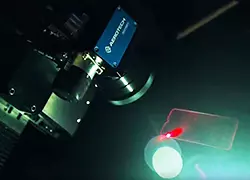What Is a Laser Scan Head? | Functions, Galvo Systems & Use Cases
What is a laser scan head? A laser scan head is a sophisticated device that steers a laser beam with incredible speed and precision. In any advanced...
Work with our team to determine which products or systems are the best fit for your application.
Some Aerotech products are available for immediate order in North America through our partner Motion Plus.

A case study examining display production that optimizes quality and throughput – and lower total cost.
3 min read
 Bryan Germann
Jun 30, 2025 2:25:24 PM
Bryan Germann
Jun 30, 2025 2:25:24 PM
A galvo laser scan head is a powerful and versatile tool used across a wide range of high-precision manufacturing applications. Its primary purpose within precision laser material processing is to rapidly and accurately steer a laser beam to perform tasks like cutting, marking, drilling and welding. The "galvo" component is what gives the system its incredible speed and agility, allowing it to create intricate patterns and process features at speeds that are impossible with other motion technologies.
From marking serial numbers on consumer electronics to cutting life-saving medical devices, a galvo laser system is the enabling technology behind countless products we use every day. Its ability to deliver precisely controlled energy makes it indispensable in modern industrial processes where quality, throughput and complexity are paramount.
From marking serial numbers on consumer electronics to cutting life-saving medical devices, a galvo laser system is the enabling technology behind countless products we use every day
A galvo laser is not a specific type of laser source itself, but rather a complete system that combines a laser source with a galvanometer-based scan head. The "galvo" part refers to the beam steering mechanism. This means you can have a galvo CO2 laser for processing organic materials or a UV galvo laser for micromachining plastics with minimal heat damage. The term laser galvo simply describes the pairing of a laser with this high-speed scanning technology.
The scan head contains small mirrors mounted on fast, precise motors (galvanometers). These mirrors direct the laser beam from the source onto the workpiece. By controlling the angle of these mirrors, the system can "draw" with the laser beam at extremely high speeds.
Galvo scanners work on a principle of closed-loop motion control. Here’s a simple breakdown of the process:
Command: A computer sends a command to the scanner’s controller, indicating the desired position of the laser spot.
Actuation: The controller applies a current to the galvanometer motors, causing them to pivot the mirrors.
Feedback: High-resolution sensors called encoders continuously measure the exact angle of the mirrors and send this information back to the controller.
Correction: The controller compares the actual position to the commanded position and instantly adjusts the current to correct any error.
This feedback loop occurs thousands of times per second, ensuring the mirrors follow the programmed path with exceptional accuracy, even while moving at several meters per second.
A galvo's primary function is to steer a laser beam. It translates digital commands into precise, two-dimensional physical motion. By doing so, a galvo can make a laser beam perform several key actions:
Vector Motion: It can trace complex, continuous paths to cut shapes, scribe lines or engrave logos.
Raster Motion: It can sweep the beam back and forth to fill in an area, which is common for surface texturing or creating deep engravings.
Point-to-Point Motion: It can jump the laser spot from one position to another almost instantaneously, which is ideal for drilling dense patterns of holes.
In essence, a galvo takes a static beam of light and makes it a dynamic and highly flexible manufacturing tool.
Yes, absolutely. A galvo laser is an excellent tool for cutting, especially when high speed and intricate detail are required. The agility of the galvo mirrors allows it to trace complex patterns far faster than a conventional gantry system can move a cutting head.
There are many materials that can be laser cut using a galvo system, though it is best suited for thinner materials where its speed can be fully leveraged. Common materials include:
Thin Metals: Galvos are used to cut intricate patterns in thin metal foils and sheets for medical devices like stents and electronic components like connectors.
Polymers and Plastics: They excel at cutting flexible circuits, gaskets, films and other plastic-based materials with clean, precise edges.
Textiles and Leather: The high speed of a galvo scanner is perfect for rapidly cutting complex patterns for clothing, upholstery and footwear.
Brittle Materials (for Scribing): While not cutting all the way through, galvos are used to create fine, precise scribe lines on materials like glass and silicon wafers. This scribing creates a line of weakness for a clean, controlled break.
What is a laser scan head? A laser scan head is a sophisticated device that steers a laser beam with incredible speed and precision. In any advanced...
What is beam steering used for? Beam steering is the technology used to rapidly and precisely control the direction of a laser beam. In advanced...
Galvo Laser Scan Heads In the world of precision laser material processing, speed and accuracy drive innovation and productivity. The ability to...